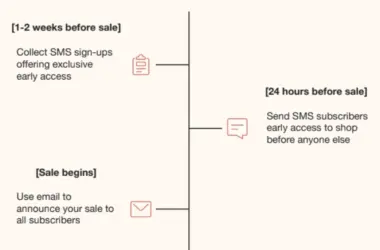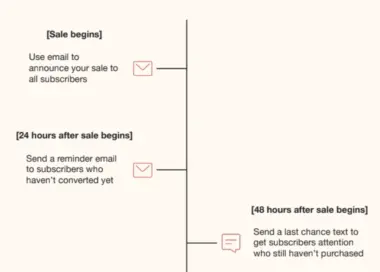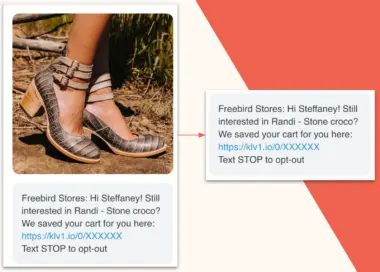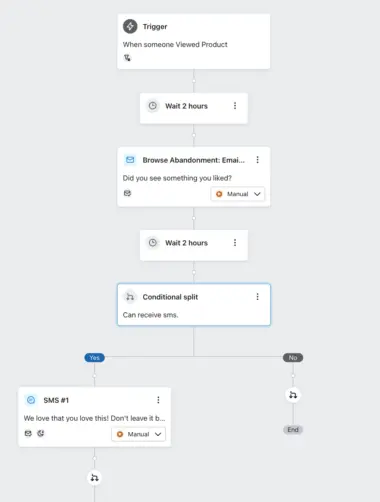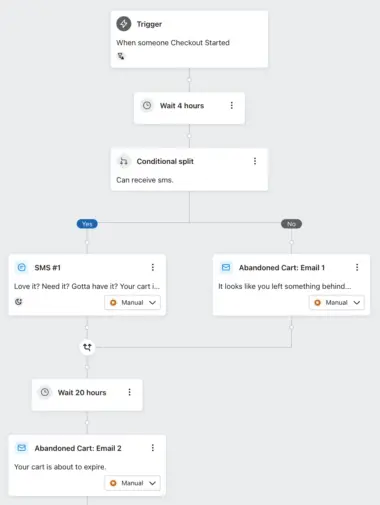A step-by-step guide to integrating email & SMS
Welcome to your tactical guide to coordinating multi-channel campaigns and flows.
The #1 way to increase ROI through SMS marketing is to leverage it alongside your email marketing strategy.
One of the biggest SMS marketing myths that prevents ecommerce brands from investing in an SMS marketing platform is that it’s too expensive.
And it’s true that “SMS is more expensive than email,” says Jacob Sappington, head of email at ecommerce growth marketing agency Homestead Studio. But it’s also true that SMS marketing can pay for itself—and then some.
So how do you, as Sappington puts it, “optimise in a way that leads to the most dollars”?
The No. 1 way to increase return on investment through SMS marketing, experts agree, is to leverage it alongside a strong email marketing strategy.
“Email as a channel has been super high-performing for at least the last 10-15 years,” says Jessica Schanzer, lead product marketing manager at Klaviyo. “We don’t see SMS as a replacement channel—it’s something you do to supplement and enhance your existing email strategy to help drive even more revenue.”
In fact, when you do it right, pairing SMS with email can actually save you money because it enables you to make smarter decisions around which channel you’re using for outreach, based on subscriber behaviour, channel engagement, and more.
“Once people start trying it, they see huge ROIs,” says Mason Wheeler, former customer education specialist at Klaviyo. “I truly believe SMS is the future of high-engagement digital marketing.”
But how, exactly, do you go about braiding your email and SMS marketing strategies together in a way that not only meets your customers where they’re at, but also drives real revenue for your business?
Welcome to your tactical guide to coordinating multi-channel campaigns and flows.
Maximising email & SMS campaign revenue
When communicating with your customers across channels, Melissa Matusky, manager and implementation consultant at Klaviyo, urges marketers to “be really smart about when you use each channel in a way that makes sense for you as a brand—in terms of your spend, your wider messaging strategy, and what kinds of experiences you’re trying to create overall.”
Mindy Regnell, head of market intelligence at Klaviyo, suggests thinking about it in terms of the “size” of the marketing moment you’re orchestrating: “For smaller moments, it makes sense to pick the channel best suited for the content,” she explains. “For bigger moments, consider using both channels—keeping in mind that SMS and email should be handled a bit differently.”
“Saying the exact same thing over text and email is a huge miss,” Schanzer agrees. “Brands definitely need to tailor their content to each channel.”
Here’s how to do that.
How to coordinate multi-channel campaigns
Within a multi-channel campaign, Schanzer says email is ideal for “anything longer-form that’s information-heavy, with lots of images or links to click on”—things like:
- Brand and product storytelling
- Letters from the founder
- User-generated content (UGC) and social proof
- Newsletter, video, or podcast content
“That’s gonna be a wicked lot of credits spent for SMS,” points out Savannah Mazola, onboarding implementation consultant at Klaviyo. “But more importantly, that content’s just better over email. Nobody wants to read a 5-paragraph essay on their phone.”
Regnell believes longer texts can be effective, “but only within reason. Don’t send a text so long someone can’t easily read it.”
Which comes first, the email or the text?
The ideal sequence for your multi-channel campaign depends on your brand and the goals of your campaign, but will typically follow one of 3 tracks:
Buban sees this strategy most frequently during bigger sales, like BFCM, with additional texts scattered throughout the campaign.
How to coordinate multi-channel flows
Don’t let the success of your multi-channel campaigns let you forget about multi-channel automations, or flows—a common mistake, especially when it comes to SMS.
“More often than not, in my experience, SMS flows actually generate more sales than campaigns,” says Elliot Scott, founder and CEO of London-based retention agency ElliotDigital.
That’s because shoppers on the receiving end of flows “have really high intent,” Scott explains. “These are people who’ve not only signed up for SMS, but they’ve also got a product and they come back again and again and again.”
Sappington has observed the same: “Automations tend to pull in a significant portion of SMS revenue. The efficiency there is just much higher than the efficiency on campaigns.”
Klaviyo recommends incorporating SMS into at least 3 of your flows, such as:
In fact, besides welcome flows, which need to be channel-specific based on the specific list the subscriber signed up for, experts agree that pretty much every flow would benefit from incorporating both email and SMS.
Content and cadence best practices
Within flows, reserve visual storytelling for emails and straightforward urgency for texts. “You still want to include those dynamic variables just like you would in an email, but you want to pare it down for SMS,” Buban explains.
Let’s say someone abandons 3 products in their cart. In an abandoned cart email, you might include all 3 product names and images, as well as several personalised product recommendations, each with its own CTA. You might even incorporate contact information for customer support, in case the shopper needs help finding what they’re looking for.
An abandoned cart text, on the other hand, should be much more straightforward, Mazola and Buban agree: the name of the first product the shopper left in their cart, a coupon code if you’re offering one, a single link to return and purchase, and possibly a corresponding product image.
Which comes first, the email or the text?
As with campaigns, optimising sequencing within a flow depends on your brand’s strategy. Here are 2 common tracks to consider:
If you’re cost-conscious, remember: Sending an email costs less than a text. Seeing if your subscriber will engage with an email first, then following up with a text if they don’t, is an especially smart strategy for lower-intent flows like browse abandonment.
“If someone’s only viewed a product, I probably wouldn’t jump to SMS first,” Mazola says.
“Remember, consumers see and engage with texts very quickly, so you’ll want to balance urgency with the level of intent,” Regnell explains. “When customers are still toward the top of the funnel, it makes more sense to start with an email.”
Then, think about flow branching beyond just whether the shopper is subscribed to SMS. For example: Have they purchased before? Have they viewed more than 2-3 products? “When you have information that someone browsing has higher intent, it’s worth testing to see if SMS can help close the sale,” Regnell says.
How to optimise your multi-channel marketing efforts for ROI
Buban’s No. 1 piece of advice for marketers who want to use SMS in tandem with email to boost ROI: A/B test.
“It’s never a one shoe fits all,” Buban says. “Yes, we have best practices, but you should always A/B test as much as you can to figure out what your specific customers engage with most, and then use that to further develop your strategy and maximise your ROI.”
Within your multi-channel campaigns and flows, consider A/B testing the following to see which drive higher click rates and placed order rates:
- Personalisation vs. non-personalisation
- Incentive vs. no incentive
- CTA language, position, and design
- Emojis vs. no emojis
- More copy vs. less
- Copy voice and tone
- Time of day
- Day of week
- Different segments
- Type of incentive (i.e., dollar off, percentage off, free gift, etc.)
- MMS vs. SMS
- Sequence of flow paths (i.e., email vs. SMS first)
An all-in-one platform: the only solution for complex marketing initiatives
All of the above is a whole lot easier, experts agree, when you use a unified email and SMS marketing platform like Klaviyo.
That’s what’s so “great and strong about Klaviyo,” Wheeler says—“you have that information about your customer all in one place, so you can understand what kinds of messages they respond to and how they engage with each channel.”
Schanzer summarizes it this way: “Combining SMS and email in a single platform means you have a single place for list growth and consent management, it means you have more accurate attribution across channels, it means you’re better at coordinating your customer communications, and it rounds out your database so you’re able to use the right integrations to power the right messages at the right time.”
Here are a few reasons why unifying your email and SMS within the same marketing platform is essential:
When you run email and SMS in different platforms, you get inevitable data gaps and latencies that create delays and redundancies in your customer communications. By contrast, in Klaviyo, “real-time data determines which experience each customer is going to receive,” explains Rob Hand, lead product marketing manager at Klaviyo.

